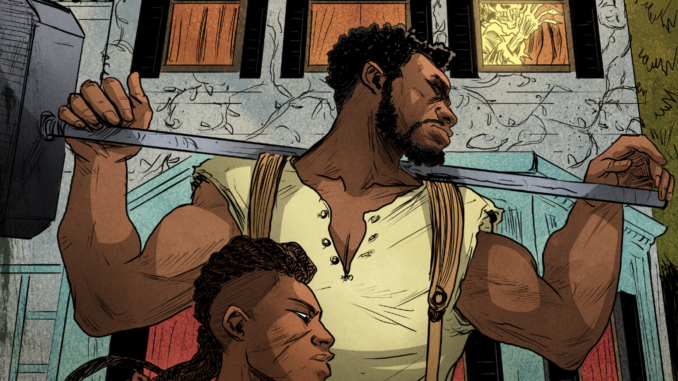
There’s something about folklore, horror and science-fiction that fuels the imagination and seems the right fit for comic-books. ‘Is’Nana The Were Spider: The Ballads of Rawhead and John Henry’ seamlessly mixes these genres to create two narratives that speak of fear and the choices we make.
‘The Ballad of John Henry’ is not a new story. It’s been retold in music and literature, but what makes Greg Anderson Elysee’s version rich is that he gives John Henry a purpose that outpaces his ability to handle a hammer. In the longstanding folkloric tale, John Henry single handedly races and defeats a steam-driven rock drill. He wins and loses his life in the process. His strength is celebrated. But in reality John Henry is the sacrifice of progress where he does not get to reap the rewards of his success. His death has no clear purpose other than showing a black man’s prowess and possibly how he has been systematically used by the dominant society. But what if John Henry was transported away from his story and taken to a world infested with machines that use human beings as fuel? This powerful man becomes more than a myth. Rather Elysse allows John Henry to be a man who is able to make choices for himself.
With John Henry’s ballad as bookends, the reader is brought into the ballad of Rawhead. According to stories from the American South, Rawhead is the creature who will take children away from their homes if they are bad. It’s the boogeyman and the legend is meant to keep children from misbehaving. For two boys moving into a new home with their father, that story doesn’t sit well with young Isaiah. He’s lost his mother and his brother’s way of coping is bullying him. But where there’s boogeymen, there are stories and the son of Anansi loves a good story.
Through both ballads is Is’Nana. He and his father the trickster god find ways to resolve issues in both stories. But then that’s what comic-books are about. Essentially, they are stories told to entertain, inform and warn us. They help us to remember to be kind and give us hope that the human spirit isn’t dead. At the end of this comic is an essay by John Jennings detailing the importance and tradition of music and storytelling. It’s a reminder of why horror is mixed in these tales. Horror can connect us especially through the children’s nursery rhymes involving the Black Plague. It takes an insidious event in history and makes it something that children sing to entertain themselves. But the warnings from Candyman, Bloody Mary and Freddy’s ‘9, 10 never sleep again’ bring out our worst fears. Context is important and Elysee’s use of Anansi folklore helps us to collect these horrors and put them in the right perspective.

Leave a Reply